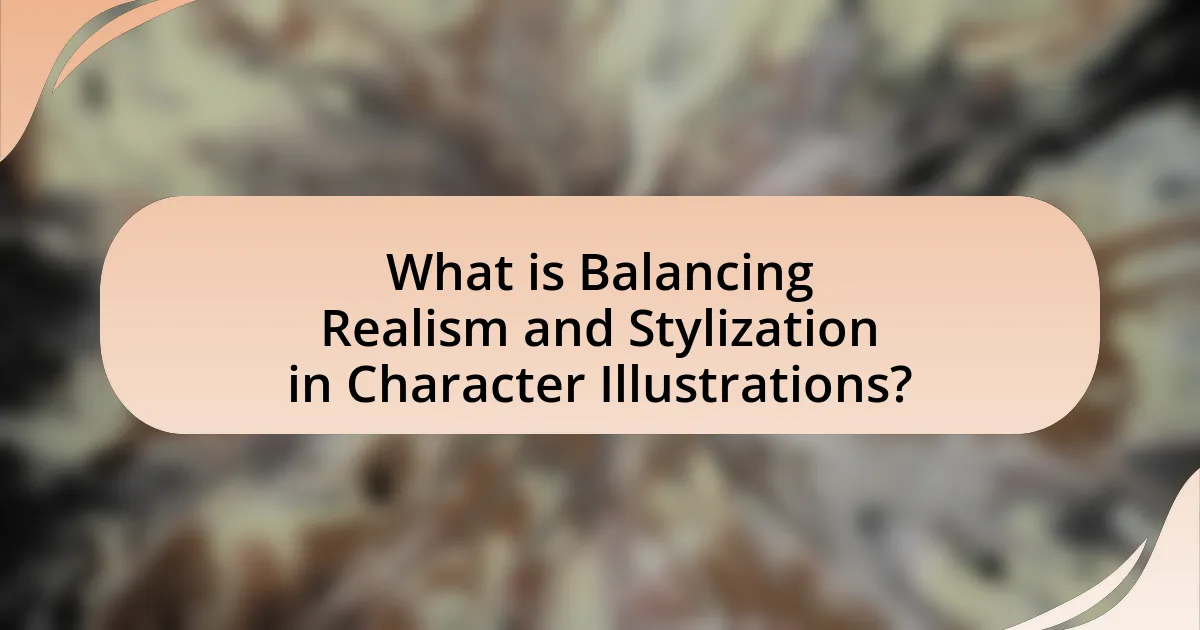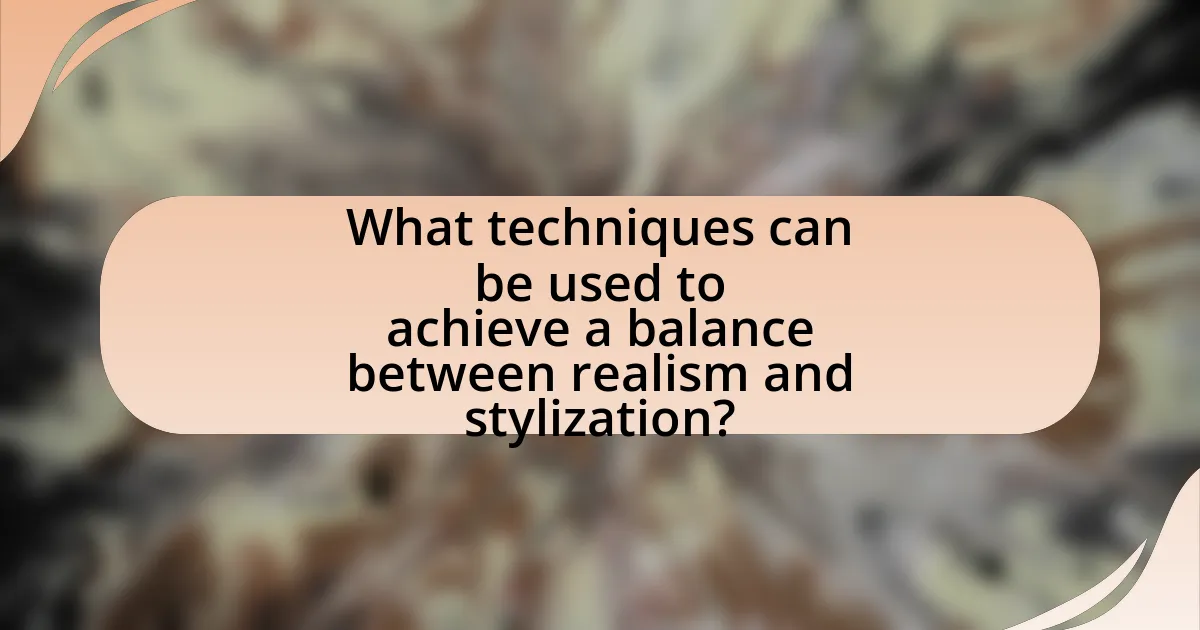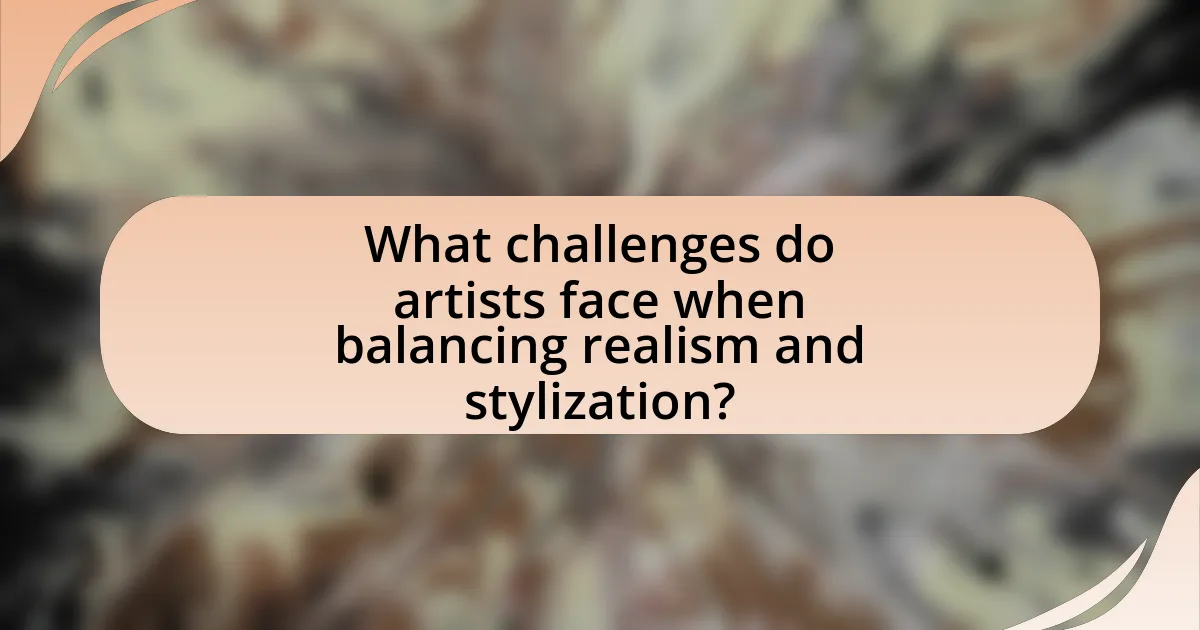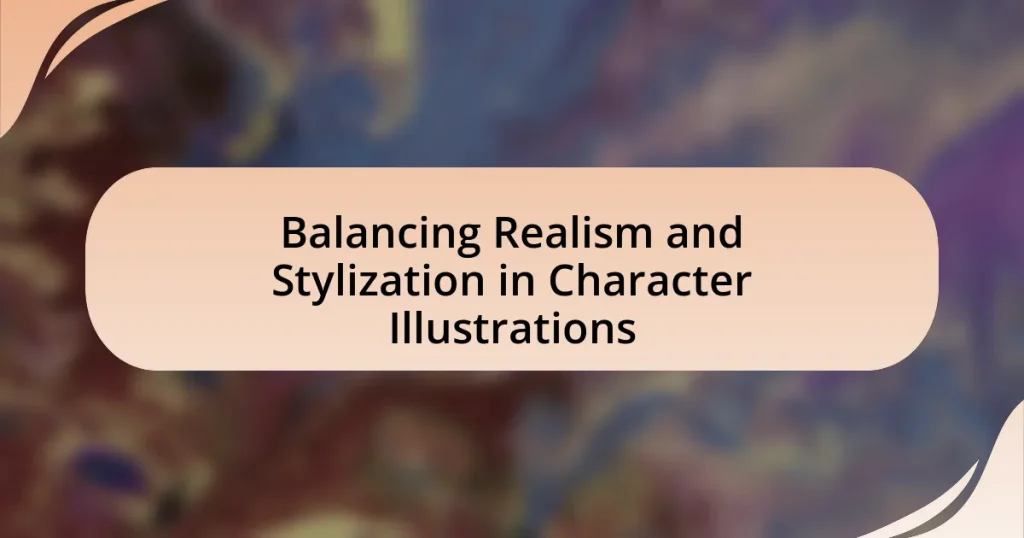Balancing realism and stylization in character illustrations is a critical aspect of character design that combines lifelike qualities with artistic exaggeration to enhance emotional impact and visual appeal. The article explores the differences between realism and stylization, highlighting their defining characteristics and the importance of achieving a balance for audience engagement. It discusses techniques for blending these styles, the role of context in determining stylistic choices, and the challenges artists face in maintaining this equilibrium. Additionally, it outlines best practices and tools that can assist artists in creating compelling character illustrations that resonate with viewers.

What is Balancing Realism and Stylization in Character Illustrations?
Balancing realism and stylization in character illustrations involves creating characters that possess both lifelike qualities and artistic exaggeration. This balance allows artists to convey emotions and personality traits effectively while maintaining visual appeal. For instance, a character may have realistic facial features but stylized proportions, such as oversized eyes or exaggerated expressions, to enhance emotional impact. This approach is supported by the principle that stylization can make characters more relatable and memorable, as seen in successful animated films where characters blend realistic textures with simplified forms.
How do realism and stylization differ in character illustrations?
Realism and stylization in character illustrations differ primarily in their approach to depicting characters. Realism aims to represent characters as accurately as possible, focusing on lifelike proportions, textures, and details that mimic real-life appearances. In contrast, stylization emphasizes artistic interpretation, often exaggerating features or simplifying forms to convey emotions or themes, resulting in a more abstract representation. For example, realistic illustrations may include intricate details like skin texture and accurate anatomy, while stylized illustrations might use bold colors and exaggerated shapes to evoke a specific mood or style. This distinction is crucial in character design, as it influences the viewer’s perception and emotional response to the artwork.
What are the defining characteristics of realism in character design?
Realism in character design is characterized by accurate anatomical proportions, lifelike textures, and emotional expressiveness. Accurate anatomical proportions ensure that characters reflect human or animal forms realistically, adhering to the laws of physics and biology. Lifelike textures involve the use of detailed surface qualities, such as skin, hair, and clothing, which mimic real-world materials and their interactions with light. Emotional expressiveness is achieved through subtle facial expressions and body language that convey genuine feelings, enhancing the character’s relatability. These characteristics collectively create a believable and immersive experience for the audience, making the characters feel authentic and engaging.
What are the defining characteristics of stylization in character design?
Stylization in character design is characterized by the simplification and exaggeration of features to create a distinct visual identity. This approach often involves altering proportions, using bold colors, and emphasizing specific traits to convey personality or emotion effectively. For instance, characters in animation frequently exhibit oversized heads or eyes to enhance expressiveness, a technique supported by studies in visual perception that show exaggerated features can evoke stronger emotional responses from audiences. Additionally, stylization can reflect cultural influences, as seen in various art movements, where artists adapt forms to align with specific aesthetic values, further validating the significance of stylization in character design.
Why is balancing realism and stylization important in character illustrations?
Balancing realism and stylization in character illustrations is crucial because it enhances visual appeal while maintaining relatability. Realism provides a sense of authenticity that allows viewers to connect emotionally with characters, while stylization adds uniqueness and artistic expression that can make characters memorable. For instance, animated films often blend realistic human features with exaggerated expressions to evoke emotions effectively, as seen in Pixar’s character designs. This balance ensures that characters resonate with audiences, making them more engaging and impactful.
How does this balance affect audience perception?
The balance between realism and stylization in character illustrations significantly influences audience perception by shaping their emotional connection and engagement with the characters. When illustrations lean towards realism, audiences may perceive characters as relatable and authentic, fostering empathy and a deeper emotional response. Conversely, stylized illustrations can evoke a sense of whimsy or fantasy, allowing audiences to engage with characters in a more imaginative context. Research indicates that characters designed with a balance of both styles can enhance viewer enjoyment and investment, as seen in animated films where character design impacts audience relatability and emotional resonance. For instance, Pixar’s use of stylized yet relatable characters in films like “Toy Story” demonstrates how this balance can create a strong connection with viewers, leading to increased emotional engagement and overall satisfaction.
What role does context play in determining the balance between realism and stylization?
Context plays a crucial role in determining the balance between realism and stylization in character illustrations by influencing the intended message, audience perception, and cultural references. For instance, a character illustration in a fantasy setting may lean towards stylization to evoke a sense of whimsy, while a depiction in a historical context may require realism to convey authenticity. Research indicates that audience expectations, shaped by cultural and situational context, significantly affect how illustrations are interpreted; for example, a study by McCloud in “Understanding Comics” highlights that different genres prompt varying levels of realism or stylization based on the narrative’s demands. Thus, context directly informs the stylistic choices made by artists, ensuring that the illustrations resonate effectively with viewers.

What techniques can be used to achieve a balance between realism and stylization?
To achieve a balance between realism and stylization in character illustrations, artists can employ techniques such as selective exaggeration, color theory application, and texture manipulation. Selective exaggeration involves emphasizing certain features while downplaying others, allowing for a stylized representation that retains recognizable elements of realism. For instance, an artist might enlarge the eyes or simplify facial features while maintaining realistic proportions in the body.
Color theory application can enhance the emotional impact of an illustration while still adhering to realistic color palettes. By using vibrant colors in specific areas, artists can draw attention and create a stylized effect without losing the overall realism of the character.
Texture manipulation allows artists to blend realistic textures with stylized forms, creating depth and interest. For example, a character may have realistic skin textures combined with stylized clothing patterns, achieving a cohesive look that balances both styles. These techniques, when applied thoughtfully, enable artists to create character illustrations that resonate with both realism and stylization.
How can artists incorporate both realism and stylization in their work?
Artists can incorporate both realism and stylization in their work by blending accurate anatomical proportions and lifelike textures with exaggerated features and vibrant colors. This approach allows artists to maintain a foundation of realism while infusing their unique artistic voice. For instance, artists can study human anatomy to create realistic body structures and then apply stylized elements, such as oversized eyes or simplified shapes, to enhance expressiveness. This technique is evident in the works of contemporary illustrators who often combine realistic backgrounds with stylized characters, creating a dynamic visual contrast that engages viewers.
What are some common methods for blending realistic features with stylized elements?
Common methods for blending realistic features with stylized elements include the use of exaggerated proportions, selective detailing, and color manipulation. Exaggerated proportions allow artists to emphasize certain features while maintaining a recognizable form, as seen in many animated characters that retain human-like traits but with altered sizes. Selective detailing focuses on rendering specific areas realistically, such as facial expressions or textures, while simplifying other parts, which creates a contrast that enhances the overall design. Color manipulation involves using vibrant or unconventional color palettes to evoke emotion and style, even when realistic textures are applied. These techniques are widely used in character design across various media, demonstrating their effectiveness in achieving a harmonious balance between realism and stylization.
How can color and texture contribute to this balance?
Color and texture significantly contribute to balancing realism and stylization in character illustrations by influencing visual perception and emotional response. Color can evoke specific feelings and set the tone of the illustration; for instance, warm colors often create a sense of comfort or energy, while cool colors can convey calmness or detachment. Texture adds depth and dimension, making characters appear more lifelike or stylized depending on its application. For example, a smooth texture may enhance a stylized look, while a rough texture can ground a character in realism. Research indicates that the combination of color and texture can affect viewer engagement and interpretation, as seen in studies on color psychology and visual aesthetics.
What tools and software can assist in achieving this balance?
Tools and software that can assist in balancing realism and stylization in character illustrations include Adobe Photoshop, Corel Painter, and Procreate. Adobe Photoshop offers advanced features for digital painting and photo manipulation, allowing artists to blend realistic textures with stylized elements effectively. Corel Painter specializes in mimicking traditional painting techniques, providing a wide range of brushes that can create both realistic and stylized effects. Procreate, popular among digital illustrators, offers intuitive tools and customizable brushes that facilitate the integration of realism and stylization in character designs. These tools are widely used in the industry, demonstrating their effectiveness in achieving the desired artistic balance.
Which digital tools are best for character illustration?
The best digital tools for character illustration include Adobe Photoshop, Clip Studio Paint, and Procreate. Adobe Photoshop is widely used for its extensive features and versatility, allowing artists to create detailed and high-quality illustrations. Clip Studio Paint is favored for its specialized tools for comic and manga artists, offering excellent brush customization and vector capabilities. Procreate is popular among iPad users for its intuitive interface and powerful features, making it ideal for on-the-go illustration. These tools are recognized in the industry for their ability to balance realism and stylization effectively, catering to various artistic styles and preferences.
How can traditional techniques complement digital methods in this context?
Traditional techniques can enhance digital methods in character illustrations by providing a foundational understanding of art principles and tactile experiences that inform digital practices. For instance, artists who utilize traditional drawing and painting techniques develop skills in color theory, composition, and texture, which can be directly applied to digital platforms. Research indicates that artists who engage in both traditional and digital mediums often produce more nuanced and visually appealing work, as they can blend the spontaneity and organic qualities of traditional art with the precision and versatility of digital tools. This synergy allows for a richer exploration of styles, ultimately leading to more balanced and compelling character illustrations.

What challenges do artists face when balancing realism and stylization?
Artists face the challenge of maintaining visual appeal while ensuring accurate representation when balancing realism and stylization. This balance requires artists to make decisions about which elements to exaggerate or simplify, impacting the emotional resonance and narrative clarity of their work. For instance, stylization can enhance expressiveness but may sacrifice detail, leading to potential misinterpretation of character traits. Additionally, artists must navigate audience expectations; a highly stylized character might not resonate with viewers seeking realism, while a realistic portrayal may lack the imaginative qualities that stylization offers. This tension between artistic intent and viewer perception complicates the creative process, making it essential for artists to find a harmonious blend that satisfies both aesthetic and communicative goals.
What are common pitfalls in character illustration regarding this balance?
Common pitfalls in character illustration regarding the balance between realism and stylization include overemphasis on either extreme, leading to a lack of relatability or expressiveness. When artists focus too much on realism, characters may appear stiff or lifeless, failing to convey emotion effectively. Conversely, excessive stylization can result in characters that lack depth or believability, making it difficult for audiences to connect with them. For instance, a study by the University of Southern California found that characters with a balanced approach to realism and stylization are more engaging and memorable to viewers, highlighting the importance of achieving this equilibrium in character design.
How can overemphasis on realism detract from artistic expression?
Overemphasis on realism can detract from artistic expression by limiting creativity and personal interpretation. When artists focus excessively on replicating reality, they may suppress their unique styles and emotional resonance, resulting in work that feels mechanical or uninspired. For instance, studies in art psychology indicate that artists who prioritize realism often experience constraints in exploring abstract concepts or imaginative themes, which are essential for conveying deeper narratives and emotions. This reliance on realism can lead to a lack of innovation, as seen in movements like Impressionism, where artists broke away from strict realism to express subjective experiences and perceptions.
What risks are associated with excessive stylization?
Excessive stylization in character illustrations can lead to a disconnect between the character’s design and audience perception, resulting in misinterpretation of the character’s traits or intentions. This misalignment can diminish the character’s relatability and emotional impact, as overly stylized features may obscure essential characteristics that convey personality or narrative context. For instance, research indicates that characters with exaggerated features may be perceived as less trustworthy or relatable, which can negatively affect audience engagement and storytelling effectiveness.
How can artists overcome these challenges?
Artists can overcome the challenges of balancing realism and stylization in character illustrations by employing a structured approach that includes studying anatomy, utilizing reference materials, and experimenting with different styles. By studying anatomy, artists gain a foundational understanding of human and animal forms, which allows them to create more believable characters. Utilizing reference materials, such as photographs or 3D models, helps artists visualize proportions and details accurately, bridging the gap between realism and stylization. Additionally, experimenting with various artistic styles enables artists to find a unique voice that harmonizes realistic elements with their personal artistic expression. This methodical approach is supported by the fact that many successful artists, such as Glen Keane and Hayao Miyazaki, have emphasized the importance of foundational skills and experimentation in their work.
What strategies can be employed to maintain a harmonious balance?
To maintain a harmonious balance in character illustrations, artists can employ techniques such as integrating realistic proportions with stylized features. This approach allows for the retention of recognizable human characteristics while enhancing expressiveness through exaggerated elements. For instance, using a consistent color palette that reflects both realistic skin tones and vibrant stylized hues can unify the overall appearance. Additionally, employing dynamic poses that convey emotion while adhering to anatomical accuracy can further bridge the gap between realism and stylization. Research indicates that successful character design often relies on this balance, as seen in popular animated films where characters exhibit both relatable traits and imaginative features, appealing to a broad audience.
How can feedback and critique improve the balance in character illustrations?
Feedback and critique can significantly enhance the balance in character illustrations by providing objective insights into the visual elements and proportions used. When artists receive constructive criticism, they can identify areas where realism may be lacking or where stylization may be overemphasized, allowing them to adjust proportions, colors, and details accordingly. For instance, peer reviews often highlight inconsistencies in anatomy or perspective that the artist may overlook, leading to more accurate and harmonious designs. Studies in art education indicate that iterative feedback loops improve artistic skills, as artists refine their work based on specific critiques, ultimately achieving a more balanced representation that resonates with viewers.
What best practices should artists follow for effective character illustrations?
Artists should follow several best practices for effective character illustrations, including understanding anatomy, utilizing color theory, and maintaining consistency in style. A solid grasp of human and animal anatomy allows artists to create believable and dynamic poses, enhancing the realism of their characters. Color theory aids in selecting palettes that evoke the desired emotions and convey character traits effectively. Consistency in style ensures that characters remain recognizable and cohesive within the context of the artwork, which is crucial for storytelling. These practices are supported by studies in art education that emphasize the importance of foundational skills in creating compelling illustrations.


